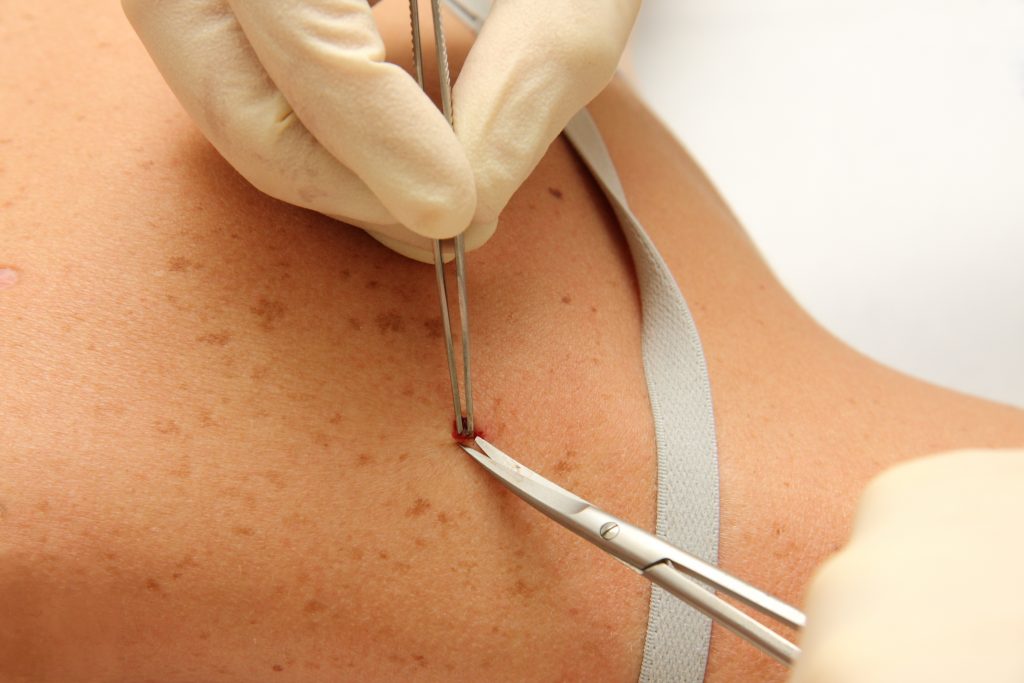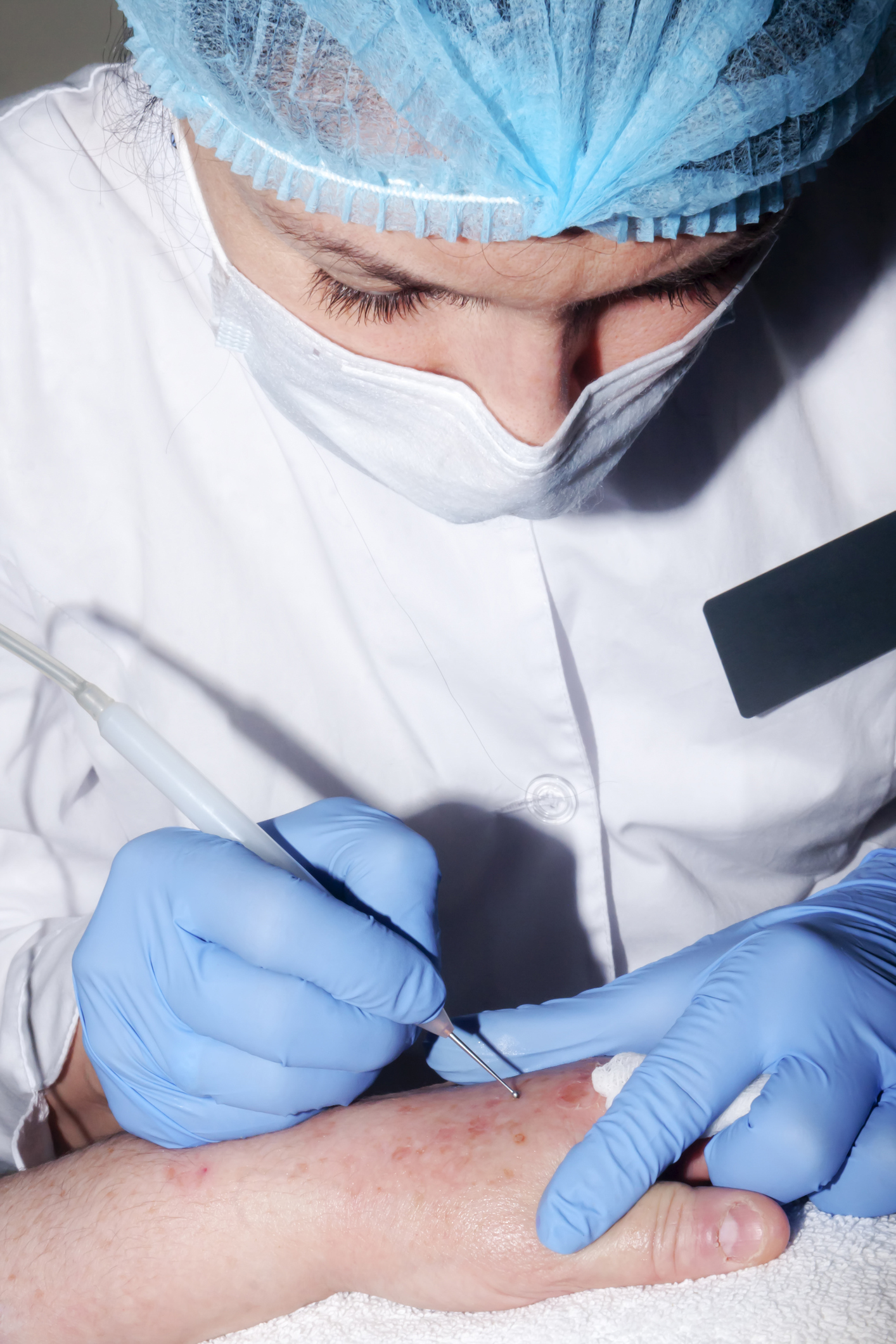Skin Cancer Treatments from U.S. Dermatology Partners
What Is Skin Cancer?
Skin cancer is the most common form of cancer in the U.S. with more than 3.5 million cases diagnosed each year.
Skin cancer is the result of uncontrolled growth of abnormal skin cells that takes place when skin cells suffer DNA damage and then mutate, causing them to multiply rapidly and form malignant (cancerous) tumors. Most skin cancers develop on the visible outer layer of the skin (the epidermis), particularly on sun-exposed areas such as the face, head, hands, arms and legs. They are usually easy to detect with a skin examination, which increases the chances of early diagnosis.
There are different types of skin cancer, each named for the type of skin cell from which they originate. The most common type of skin cancer is basal cell carcinoma. Almost one million new cases of basal cell carcinoma are diagnosed each year in the U.S. Most skin cancers fall into one of three categories:
There are often warning signs that cancer is developing. The most common are pre-cancerous lesions called actinic keratoses that often develop on sun-exposed areas. These tumors replace normal surrounding tissue and generally do not spread to other areas.
Skin cancer is considered low risk when the affected cells remain clustered in a single group. Both basal cell carcinoma and squamous cell carcinoma are rarely life-threatening.
Skin cancer is considered a high risk when cells have invaded surrounding tissues. The third most common skin cancer, malignant melanoma, can be life-threatening if not diagnosed and treated early.
If skin cancer is detected before it has spread to surrounding tissues, the chances of a complete recovery and cure are excellent. High-risk forms of cancer like melanoma require more aggressive treatments.

Suspicious moles should be watched closely, as they might indicate a cancerous growth.
Find This Service Near You
Who Is at Risk for Skin Cancer?

Woman examining a suspicious mole.
While no one is completely without risk, there are some known factors that can increase your chances of developing skin cancer. More than 90 percent of all skin cancer is caused by long-term exposure to UV radiation.
Melanin in the skin can naturally block the damaging effects of UV radiation. The more melanin in the skin, the darker the skin and the better protected it is from UV radiation. But melanin only provides partial protection.
People who use tanning beds, have fair skin and light-colored eyes, have a history of skin cancer or precancerous lesions or who have a weakened immune system all are at greater risk for skin cancer. Additionally, people with a history of sunburns (especially early in life) or those who spend an excessive amount of time in the sun are also at greater risk.
Increased skin cancer risk is also seen in people who live in sunny, warm climates, as well as those who have many moles, abnormal moles, or those who have been exposed to radiation.
While skin cancers are almost always curable when detected and treated early, the surest line of defense is prevention. Check your skin monthly. If you detect skin irregularities, consult with your dermatologist, who may suggest a full body screening exam.
Skin Cancer Symptoms

A dysplastic (atypical) mole is one that, when viewed on a cellular level, has features unlike those of a healthy, benign mole. Benign moles have a regular pattern of coloration and pigment, even borders, symmetry, and a tan or pink color. Dysplastic moles can be asymmetric, have indistinct borders, or contain multiple colors or very dark pigment.
Dysplastic moles are not yet cancerous, and are not even considered “pre-cancerous,” but they could potentially become cancerous if left untreated. Displaysia comes in varying degrees from mild to moderate to severe and the risk of developing melanoma generally correlates with the severity of abnormality.
This is why it is important to monitor atypical moles for regrowth and changes. The more dysplastic moles you have, the higher your risk of having more atypical moles (and possibly melanoma) in the future. Though dysplastic moles are more likely to develop into melanoma than benign moles, this does not mean you will have melanoma if you have dysplastic moles. But it does mean that you should watch your skin closely and take certain precautions.
- See your dermatologist for an annual skin examination.
- Be diligent about wearing sun protection of SPF 30+.
- Screen your skin monthly. Take photos as reference points and have a spouse or friend check areas that are difficult to see.
Each type of skin cancer has its own set of unique symptoms.
Basal cell carcinoma can be pink, black or brown, or it may look like a shiny pink or red patch on your skin. Sometimes, it looks like a flesh-colored mole. One main characteristic of basal cell carcinomas is that they tend to be fragile and can bleed easily. They will usually appear on areas of the body exposed to sun.
Squamous cell carcinoma symptoms may appear as a firm, red nodule; a flat sore with a scaly crust; a new sore or raised area on an old scar or ulcer; a rough, scaly patch on your lip that may grow into an open sore; a red sore or rough patch inside your mouth or a red, raised patch or wart-like sore on or in the anus or on your genitals.
Melanoma can develop anywhere on your body. The most important warning sign of melanoma is a new spot on the skin or a spot that changes in size, shape or color. Another warning sign is a spot that looks different from all of the other spots on your skin.
If you have concerns about a patch on your skin, call your dermatologist. Skin cancer is very treatable when caught early!
Skin Cancer Treatments
Most skin cancers can be removed with relatively minor surgery or occasionally with a topical medication.
For many skin cancers, surgical removal by excision or by performing Mohs micrographic surgery is the preferred treatment method. Some forms of skin cancer may be treated non-surgically using topical creams, liquid nitrogen (cryosurgery), curettage, light-based treatments or laser treatments.
Cryosurgery is a simple, non-invasive procedure in which liquid nitrogen is used to freeze and destroy growths on the surface of the skin. This is an effective treatment for precancerous skin lesions, as well as other skin conditions such as warts, skin tags and moles. Applying liquid nitrogen to skin lesions allows dermatologists to target the damaged skin cells and destroy them at the cellular level. This treatment is a simple, affordable outpatient procedure with very low risk of infection. After freezing, the affected area typically heals within three to six weeks.

Dermatologists have a variety of methods available for removing skin disease.
Curettage is commonly used to treat skin cancers found in the top layer of skin like basal cell and squamous cell cancers. Using this procedure, skin cancer is removed by scraping the area with a sharp looped-edge instrument called a curette. An electrocautery needle is then used to destroy any remaining cancer cells and help control bleeding. This process may be repeated a few times with a deeper layer of tissue being scraped and cauterized each time to help destroy all of the cancer cells.
Surgical excision is the removal of skin cancer with a scalpel under a local anesthetic. The advantage of a full skin excision is that the success rate is very high. Some surrounding normal skin is also removed to ensure the complete removal of the cancer and the wound is then repaired with sutures. Mohs micrographic surgery is a highly specialized procedure for the total removal of skin cancers under microscopic control, resulting in the smallest possible wound and highest rate of cure.
For patients unable to tolerate surgery, superficial radiation therapy may also be recommended.
Melanoma tumors must be removed surgically and preferably before they have spread beyond the skin into other organs of the body. Melanoma that has spread to other areas presents the greatest treatment challenge.
Often, melanoma can be surgically removed by your dermatologist in his office. If more extensive treatment is required, a general surgeon or surgical oncologist will discuss treatment options, which may include more extensive surgery and a lymph node biopsy. Additional treatments for melanoma may also include immunotherapy, radiation and chemotherapy treatments.
If you are diagnosed with skin cancer, your dermatologist will discuss options with you to determine the best treatment plan.
Skin Cancer Prevention
The best way to prevent skin cancer is to protect your skin from sunlight. Make smart sun habits a part of your daily healthcare regimen.
- Limit the amount of time spent outdoors during peak sun hours (10:00 AM to 4:00 PM).
- Avoid tanning booths and sunburn.
- Wear a broad spectrum (UVA/UVB) sunscreen with an SPF of 15 or higher every day.
- For extended outdoor activity, use a water-resistant, broad spectrum sunscreen with an SPF of 30 or higher.
- When outside, cover-up with long pants, a long-sleeved shirt, a broad-brimmed hat and UV-blocking sunglasses.
- Check your skin head-to-toe every month.
- See your dermatologist every year for a professional skin exam.
Rare Types of Skin Cancer
Merkel Cell Carcinoma
Merkel cell carcinoma is a very rare form of skin cancer that usually appears as a single painless bump on skin that has been exposed to the sun.
Dermatofibrosarcoma Protuberans (DFSP)
Dermatofibrosarcoma protuberans is a very rare form of skin cancer that begins in the dermis (middle layer of the skin) and then surfaces with lumps of tissue (protuberans).
Extramammary Paget’s Disease (EMPD)
Extramammary Paget’s disease is a rare, slow-growing skin cancer characterized by an eczema-like rash around the genital areas of both males and females.
Microcystic Adnexal Carcinoma (MAC)
Microcystic adnexal carcinoma is a rare form of skin cancer that develops in the sweat glands and typically appears on the face and neck.
*Results may vary by individual
